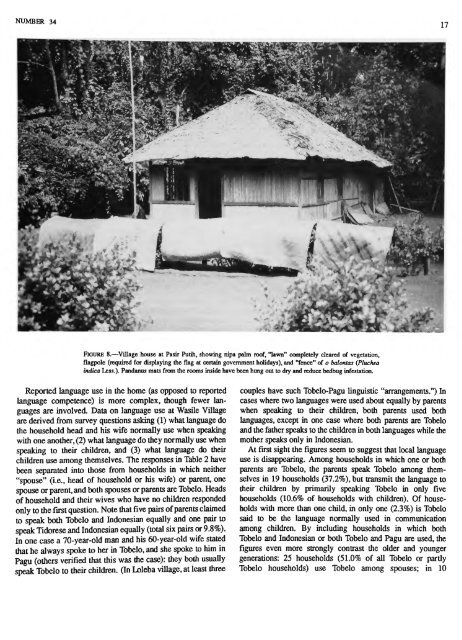The Folk Biology of the Tobelo People - Smithsonian Institution ...
The Folk Biology of the Tobelo People - Smithsonian Institution ...
The Folk Biology of the Tobelo People - Smithsonian Institution ...
Create successful ePaper yourself
Turn your PDF publications into a flip-book with our unique Google optimized e-Paper software.
NUMBER 34<br />
FIGURE 8.—Village house at Pasir Putih, showing nipa palm ro<strong>of</strong>, "lawn" completely cleared <strong>of</strong> vegetation,<br />
flagpole (required for displaying <strong>the</strong> flag at certain government holidays), and "fence" <strong>of</strong> o balontas (Pluchea<br />
indica Less.). Pandanus mats from <strong>the</strong> rooms inside have been hung out to dry and reduce bedbug infestation.<br />
Reported language use in die home (as opposed to reported<br />
language competence) is more complex, though fewer languages<br />
are involved. Data on language use at Wasile Village<br />
are derived from survey questions asking (1) what language do<br />
die household head and his wife normally use when speaking<br />
witii one anotiier, (2) what language do <strong>the</strong>y normaUy use when<br />
speaking to tiieir chUdren, and (3) what language do <strong>the</strong>ir<br />
children use among <strong>the</strong>mselves. <strong>The</strong> responses in Table 2 have<br />
been separated into those from households in which nei<strong>the</strong>r<br />
"spouse" (i.e., head <strong>of</strong> household or his wife) or parent, one<br />
spouse or parent, and both spouses or parents are <strong>Tobelo</strong>. Heads<br />
<strong>of</strong> household and tiieir wives who have no children responded<br />
only to <strong>the</strong> first question. Note that five pairs <strong>of</strong> parents claimed<br />
to speak botii <strong>Tobelo</strong> and Indonesian equally and one pair to<br />
speak Tidorese and Indonesian equally (total six pairs or 9.8%).<br />
In one case a 70-year-old man and his 60-year-old wife stated<br />
tiiat he always spoke to her in <strong>Tobelo</strong>, and she spoke to him in<br />
Pagu (otiiers verified that this was <strong>the</strong> case): <strong>the</strong>y both usually<br />
speak <strong>Tobelo</strong> to <strong>the</strong>ir children. (In Loleba village, at least three<br />
couples have such <strong>Tobelo</strong>-Pagu linguistic "arrangements.") In<br />
cases where two languages were used about equally by parents<br />
when speaking to <strong>the</strong>ir children, botii parents used botii<br />
languages, except in one case where both parents are <strong>Tobelo</strong><br />
and die fa<strong>the</strong>r speaks to <strong>the</strong> children in both languages whUe die<br />
modier speaks only in Indonesian.<br />
At first sight die figures seem to suggest tiiat local language<br />
use is disappearing. Among households in which one or botii<br />
parents are <strong>Tobelo</strong>, <strong>the</strong> parents speak <strong>Tobelo</strong> among <strong>the</strong>mselves<br />
in 19 households (37.2%), but transmit die language to<br />
tiieir children by primarily speaking <strong>Tobelo</strong> in only five<br />
households (10.6% <strong>of</strong> households witii chUdren). Of households<br />
witii more than one child, in only one (2.3%) is <strong>Tobelo</strong><br />
said to be die language normally used in communication<br />
among children. By including households in which both<br />
<strong>Tobelo</strong> and Indonesian or botii <strong>Tobelo</strong> and Pagu are used, die<br />
figures even more strongly contrast die older and younger<br />
generations: 25 households (51.0% <strong>of</strong> aU <strong>Tobelo</strong> or pardy<br />
<strong>Tobelo</strong> households) use <strong>Tobelo</strong> among spouses; in 10<br />
17

















